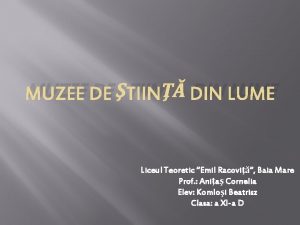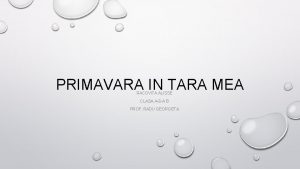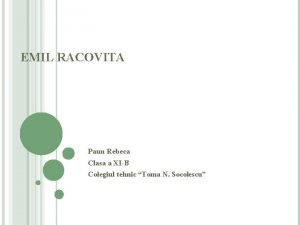Easter Traditions Racovita Alisse Clasa a 6 a





![The Easter Eggs Easter eggs, also called Paschal eggs, [1] are special eggs that The Easter Eggs Easter eggs, also called Paschal eggs, [1] are special eggs that](https://slidetodoc.com/presentation_image_h2/ab8cf5c4fc0141a9bf5f3fe835038355/image-6.jpg)




- Slides: 10

Easter Traditions Racovita Alisse Clasa a 6 -a B Prof. : Radu Georgeta

The Easter Food

The Easter

Easter is a moveable feast, meaning it is not fixed in relation to the civil calendar. The First Council of Nicaea (325) established the date of Easter as the first Sunday after the full moon (the Paschal Full Moon) following the March equinox. [7] Ecclesiastically, the equinox is reckoned to be on 21 March (although the astronomical equinox occurs on 20 March in most years), and the "Full Moon" is not necessarily on the astronomically correct date. The date of Easter therefore varies between 22 March and 25 April inclusive. Eastern Christianity bases its calculations on the Julian calendar, whose 21 March corresponds, during the 21 st century, to 3 April in the Gregorian calendar, and in which therefore the celebration of Easter varies between 4 April and 8 May.

The Easter Eggs
![The Easter Eggs Easter eggs also called Paschal eggs 1 are special eggs that The Easter Eggs Easter eggs, also called Paschal eggs, [1] are special eggs that](https://slidetodoc.com/presentation_image_h2/ab8cf5c4fc0141a9bf5f3fe835038355/image-6.jpg)
The Easter Eggs Easter eggs, also called Paschal eggs, [1] are special eggs that are often given to celebrate Easter or springtime. As such, Easter eggs are common during the season of Eastertide. The oldest tradition is to use dyed and painted chicken eggs, but a modern custom is to substitute chocolate eggs, or plastic eggs filled with confectionery such as jelly beans. Eggs, in general, were a traditional symbol of fertility, and rebirth. [2] In Christianity, for the celebration of Eastertide, Easter eggs symbolize the empty tomb of Jesus: [3][4][5] though an egg appears to be like the stone of a tomb, a bird hatches from it with life; similarly, the Easter egg, for Christians, is a reminder that Jesus rose from the grave, and that those who believe will also experience eternal life. [3][4]

The Easter Eggs

The Easter Eggs Easter eggs dyed with natural colors Preparation time : 30 minutes (the onion outer skins are put to soak with 12 hours in advance) Ingredients : outer skins from 1 kg of red onion, 5 -6 teaspoons of coffee, 1 red beet, eggs, water, 3 tablespoons of vinegar. Preparation: Dye Easter eggs in various shades of red by using outer skins of red onion. Peel the onion with one evening in advance, put the skins in water and leave them to soak for about 12 hours under a lid. Next day boil the Easter egg for 10 -15 minutes together with the onion skins and 1 tablespoon of vinegar to fix the color and leave them in liquid until you obtain the desired shades

The Easter

SFARSIT!















